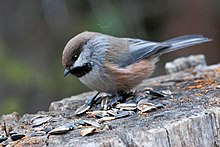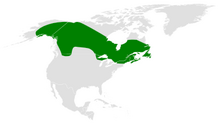Boreal chickadee
| Boreal chickadee | |
|---|---|

| |
| Scientific classification | |
| Domain: | Eukaryota |
| Kingdom: | Animalia |
| Phylum: | Chordata |
| Class: | Aves |
| Order: | Passeriformes |
| Family: | Paridae |
| Genus: | Poecile |
| Species: | P. hudsonicus
|
| Binomial name | |
| Poecile hudsonicus (Forster, 1772)
| |

| |
| Range of Poecile hudsonicus | |
| Synonyms | |
|
Parus hudsonicus | |
The boreal chickadee (Poecile hudsonicus) is a small
Description
Adults are 12.5–14.5 cm (4.9–5.7 in) long with a weight of 7–12.4 g (0.25–0.44 oz). They have grey-brown upperparts with a brown cap and greyish wings and tail; their face is mainly grey with white on the sides. Their underparts are white with brown on the flanks and a black throat. They have a short dark bill, short wings and a long notched tail. Their flight consists of brief gliding patterns followed by fast and bouncy wing beats as they travel through the air.[3]
| Standard Measurements[4][5] | |
|---|---|
| length | 130–140 mm (5–5.5 in) |
| weight | 10 g (0.35 oz) |
| wingspan | 210 mm (8.25 in) |
| wing | 63.2–66.2 mm (2.49–2.61 in) |
| tail | 59–65.9 mm (2.32–2.59 in) |
| culmen | 7.6–9.8 mm (0.30–0.39 in) |
| tarsus | 16–17.5 mm (0.63–0.69 in) |
Vocal communications
The call is a husky tsee-day-day, as well as a high pitched trill sound, dididididididi a variant on the call which gives chickadees their name.[3] This call is composed of five distinct note-type categories consisting of A, B, C, D and D-hybrid with the beginning and end note both displaying a high frequency pitch.[6] Boreal chickadees use specialized notes within their vocal range to communicate with each other and convey information.[6] Certain notes/calls can be used as a mating tactic or to indicate a bird's rank to neighbouring fertile females in the area.[7] Females have also been known to be more attracted to a male chickadee if he portrays complex and larger song repertoires.[7] Calls can also be used in territory defence or to warn others of an invader that come to close to a nesting female.[7] Cross species comparisons can be made by comparing the vocal similarities between other species of chickadee's.[6]
Breeding/nesting behaviour
Their breeding habitat is coniferous woods in Canada, Alaska, and the northernmost portions of the contiguous United States. They generally breed from early May to the end of August and remain within their breeding range throughout the year, but sometimes move south in winter.[7] When a female chickadee finds a high quality male to mate with this provides direct and indirect benefits such as exceptional parental care and high quality genes.[7] The pair remains together year round and may mate for life. Winter movements south of their range, however, appear to have become increasingly rare. Large bodies of water and mountain ranges may restrict dispersal of the boreal chickadee into places such as the Vancouver Islands and Haida Gwaii.[8] They nest in a hole in a tree; the pair excavates the nest, using a natural cavity or sometimes an old woodpecker nest. This nest can be made of hair, fur or dead plants.[3] Five to seven eggs are laid, white with fine reddish-brown spotting.[4] Eggs are laid between May and July and hatch within 13–16 days.[7] After the eggs have hatched it takes another 16–18 days for the birds to fully develop wings large enough to attempt flight.[7]
Foraging behaviour
These birds forage on conifer branches or probe into the bark, gleaning insects and foraging for conifer seeds, which may be stored in preparation for winter months.
Predators
With the advantage of being a winged bird, the boreal chickadee has few predators. These consist of larger birds such as small owls, hawks and shrikes.[3] Predators of eggs and baby boreal chickadees generally consist of tree climbing animals such as squirrels, chipmunks, mice, bears and rats.[11]
Threats
The largest threat that is placed on boreal chickadees is clearcutting and logging that occurs in the boreal forest regions.[12] These practices are causing dramatic reductions in mature forests and rapidly modifying the habitat of boreal chickadees.[12]
Taxonomy
The species was formerly placed in the genus
References
- .
- .
- ^ a b c d e Bird, D.M (2010). Birds of Canada. Toronto: Dorling Kindersley. pp. 306–328.
- ^ a b Godfrey, W. Earl (1966). The Birds of Canada. Ottawa: National Museum of Canada. pp. 279–280.
- ISBN 0-679-45122-6.
- ^ PMID 21568433.
- ^ a b c d e f g Trout-Haney, Jessica (2010). Breeding biology and genetic mating system of the Boreal Chickadee (Poecile hudsonicus). Ann Arbor. pp. 1–47.
{{cite book}}: CS1 maint: location missing publisher (link) - PMID 23759728.
- ^ JSTOR 3676058.
- S2CID 5838855.
- S2CID 85777942.
- ^ S2CID 86328417.
- S2CID 86067032.
- PMID 23831453.
- PMID 27965081.
External links
- Boreal chickadee Species Account – Cornell Lab of Ornithology
- Canadian boreal chickadee stamp[usurped] at www.bird-stamps.org[usurped]
- Boreal chickadee photo gallery at VIREO (Drexel University)
- Article on "Maine's Boreal Species" at the Maine Birding Trail
- BirdLife species factsheet for Parus hudsonicus
- "Poecile hudsonicus". Avibase.
- "Boreal chickadee media". Internet Bird Collection.
- Interactive range map of Parus hudsonicus at IUCN Red List maps
- Audio recordings of Boreal chickadee on Xeno-canto.
- Poecile hudsonicus in Field Guide: Birds of the World on Flickr
- Boreal chickadee media from ARKive

